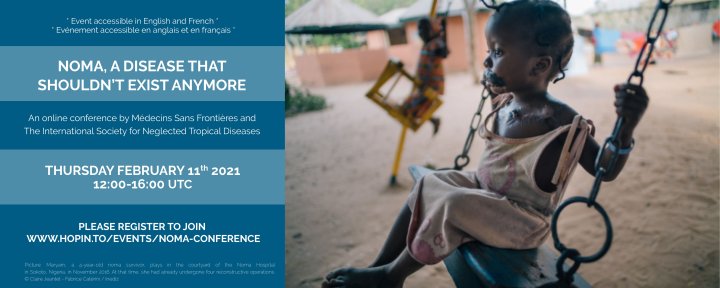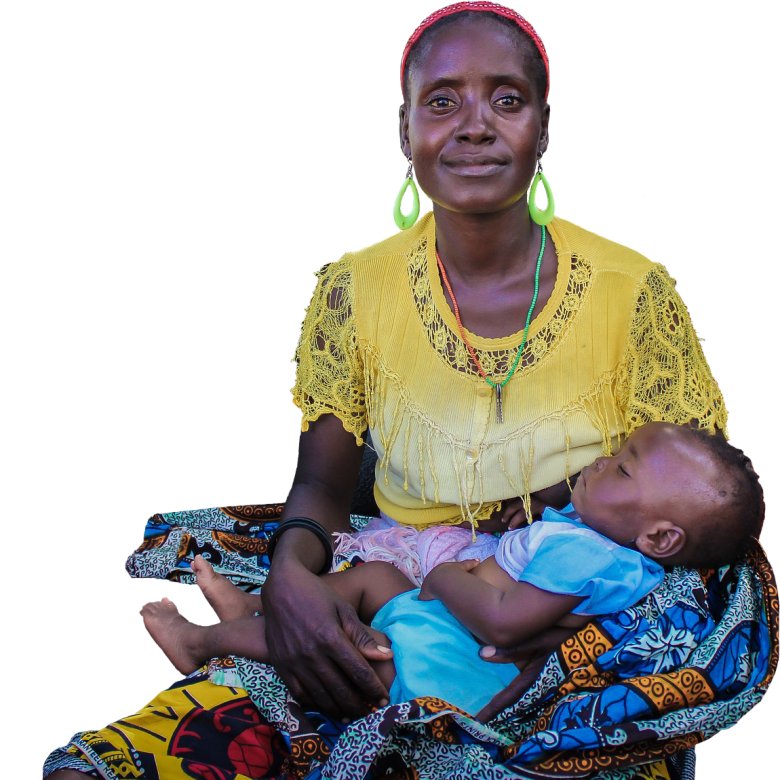Noma: a preventable but neglected disease
Noma begins as a mouth ulcer, shortly followed by the disintegration of the cheek, jaw, lip, nose or eye.
The World Health Organisation (WHO) has classified noma into stages:
- stage 0: simple gingivitis,
- stage 1: acute necrotising ulcerative gingivitis,
- stage 2: oedema,
- stage 3: gangrene,
- stage 4: scarring,
- stage 5: sequelae.
If untreated in the early stages, up to 90% of patients die. Those who survive face a lifetime of functional challenges such as difficulty eating and speaking. Those with noma and their families frequently suffer stigmatisation.
Treatment with antibiotics, wound debridement and nutritional support in the early reversible stages of the disease can reduce mortality and morbidity. The infection can become inactive (with or to a lesser extent without antibiotic treatment), after which, patients require complex surgical reconstruction.

Children most affected
Noma mostly affects children aged between two and seven years who are malnourished, who currently, or in the prior three months, have had a comorbidity such as measles and who live in low socioeconomic settings.
The cause of noma is unknown. Noma is not contagious. Noma can be prevented by ensuring children have access to an adequate amount of nutritious food, quality healthcare including childhood vaccinations and by encouraging breastfeeding and healthy oral hygiene practices.
An ancient disease
Noma has been around for centuries and was reported by physicians such as Hippocrates. Historically, noma was reported in Europe, with improvements in living standards in this setting, noma cases have been eradicated.
The WHO estimates that 140,000 new cases of noma occur globally each year, most of these are reported in low and middle-income countries in Africa and Asia.
Gaps in knowledge
There are many gaps in knowledge around noma, including the number and global distribution of cases, the etiology of noma and the risk factors for progression to the later stages of the disease.
Noma is infrequently taught in medical, nursing or tropical medicine courses and this leads to a lack of knowledge about noma amongst healthcare workers. This factor, paired with the rapid nature of the infection and the rural location of patients, means that access to healthcare is challenging and even when healthcare is sought, noma is often misdiagnosed, leading to under reporting of the disease.
This feeds into the cyclical nature of the poor understanding of noma. Patients with noma often remain invisible within their communities, the health systems that are supposed to serve them and the global health community. This invisibility leads to neglect.
Global integrated approach
The overarching aim of the Sustainable Development Goals (SDGs) is to eradicate poverty and reduce the inequalities and vulnerabilities that leave people behind and undermine the potential of individuals and of humanity as a whole.
By aiming to reach the sustainable development goals, the main risk factors for noma will be addressed. If the socioeconomic status of vulnerable populations were improved, poverty (SDG 1 and SDG 8) and hunger eradicated (SDG 2) and access to quality healthcare ensured (SDG 3, SDG 9, SDG 10 and SDG 16), the main risk factors for noma would be eliminated.
The eradication of noma should be used as an indicator that the SDGs are being met and people are no longer being left behind. This eradication is possible with a global integrated approach. The methods to treat noma survivors and prevent new cases from developing exist, what is needed is the will. In addition to meeting the SDGs, several additional actions need to be taken in a global, integrated manner.
Recognise noma as an NTD
The first is the recognition of noma as a neglected tropical disease (NTD) by the WHO.
The addition of noma to the WHO list of NTDs would raise much needed awareness about the disease and facilitate the engagement of donors to support initiatives to prevent new cases from developing, provide early detection and treatment and increased access to reconstructive surgery for noma survivors.
Improve data collection and reporting
A further action would be for governments and non-governmental organisations to conduct epidemiological surveys and improve reporting so that the burden and distribution of noma can be better understood.
These surveys could be combined with other activities in line with the integrated approach suggested in the 2030 roadmap for NTDs. Examples of integrated measures include the addition of oral screenings in routine health care assessments, malnutrition surveys, vaccination campaigns and mass drug administration programmes for other NTDs.
An additional action would be to include noma in tropical medicine, medical and nurse training programmes, as well as providing training to existing healthcare workers, traditional healthcare providers and community members.
This may assist with improving case detection and improve the efficiency of referrals. If noma patients can access the care they need in the early reversible stages of the disease, the severity of the infection could be reduced and lives could be saved.
Help spread the word about noma
- Noma is a rapidly progressing infection that can lead to the destruction of the cheek, jaw, lip, nose or eye. Most of the people affected by noma are vulnerable young children, many of whom die.
- Noma is preventable and can be effectively treated if diagnosed early.
- There are many gaps in knowledge about the disease; it is relatively unknown by healthcare workers and frequently underreported.
- The eradication of noma would show that affected populations are no longer being left behind. The eradication of noma is possible with a global integrated approach.
- The addition of noma to the WHO list of NTDs would increase awareness about the disease and provide the impetus for increased research and funding for prevention and treatment programmes.
To learn more about noma, join the International Society for Neglected Tropical Diseases and Médecins Sans Frontières conference on 11 February 2021.
Please help spread the word about noma.
